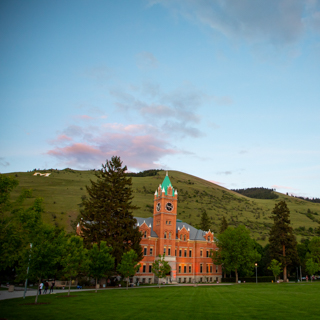Summary
The University of Montana has multiple historical and current strengths in environment and sustainability, including some programs that are highly ranked nationally. The undergraduate enrollment in E&S areas has remained relatively stable, even increasing in some areas, but significant enrollment declines across the university over the past decade have put UM in a difficult fiscal situation. All areas have absorbed significant budget cuts, with the College of Humanities and Sciences hit hardest. Additionally, the breadth of E&S offerings, with programs and relevant faculty spread across many parts of the university, has led to student confusion, internal competition, and overlap in programs that work against a clear and coordinated E&S mission.
During the 2022 spring semester, President Bodnar and Provost Humphrey invited Dr. Pamela Matson to conduct a review of UM’s E&S programs. Dr. Matson is an interdisciplinary sustainability scientist, academic leader, and organizational strategist who served as dean of Stanford University’s School of Earth, Energy, and Environmental Sciences from 2002 to 2017. Dr. Matson received a MacArthur Award in 1995 and is an elected member of the National Academy of Science and the American Academy of Arts and Sciences. See Dr. Matson’s full bio on the Stanford website.
The primary goal for the review was to determine the right mix of healthy and sustainable programs that complement one another, that provide clear and attractive student pathways, that allow for cross-college and department collaboration, and that support and enhance the research and teaching strengths of the faculty. Some key questions included: 1) How does the University take the existing offerings in E&S and build the optimal program portfolio; 2) How does that portfolio balance undergraduate, master’s, and doctoral offerings; and 3) What are the critical changes and investments that are necessary to achieve and maintain that portfolio?
Dr. Matson reviewed recent written documents from several units on campus, including departmental and program reviews, strategic initiatives and planning, educational program curricula at the undergraduate level, and more. She met individually and in small groups with university and college leaders, faculty and staff from ten academic departments, and students from H&S and FCFC during three days on campus and in over 20 hours of Zoom interviews.
Dr. Matson’s report examines several strengths in UM’s E&S programs. She discusses the breadth of faculty expertise and engagement across a number of core academic programs focused on environment, resource, and sustainability challenges. She writes about dedicated and committed students and of staff focused on supporting the strengths and opportunities in E&S.
Likewise, Dr. Matson explores UM’s E&S challenges. Cross-program tensions are too common and limit important collaboration. Some departments have been presented with an existential proposition – teach more undergraduates or disappear – and this has resulted in unhealthy competition with overlapping curricula, repetitions in courses, inefficiencies in teaching, and student confusion. Some faculty who teach and do research in E&S outside of the core E&S departments feel disconnected from the broader E&S community. There is an uneven and inequitable distribution of teaching loads and administrative duties as well as very different unit standards across E&S programs.
Dr. Matson presents several possible ways forward in her report, but what she identifies as the “Best Option” resonated with both university and college leadership as well as many E&S faculty. Dr. Matson calls for the creation of a College of X (Environment, Resources, Sustainability, or some combination thereof). The college would make UM’s efforts greater than the sum of its parts. The newly structured college would: 1) start with and build on FCFC’s components, which are already solutions-oriented and include a broad, multi- and interdisciplinary mix; 2) add Geosciences; 3) add Wildlife Biology; 4) possibly add Climate Change Studies; and 5) possibly add Environmental Studies. She also noted the importance of considering if the ecologists in the Division of Biological Sciences should also move to the new college. With this combination of expertise and educational opportunities, the new College of X would be like nothing else in the country. It would provide cutting-edge environmental and sustainability teaching and research programs that are interdisciplinary, systems-oriented, problem-focused, and engaged with communities and decision makers of all kinds, embracing issues of justice and inclusion, and seeking to build leaders.
This approach would require the shift of some programs toward greater complementarity. Some faculty “homes” might need rethinking, and flexibility for cross-unit faculty engagement would be essential. The College of X could broaden engagement with the wonderful array of field stations accessible to the university and its students, and having E&S programs in one college allows the university to invest more directly and easily in gap areas and to strengthen relationships and partnerships with Native American communities.
To further support the College of X concept, Dr. Matson argues for the development of a cross-campus collaborative. This additional entity would provide a collaborative home for faculty all over campus who do research and teach on environment and resource issues. These faculty would keep their faculty homes, but the E&S collaborative would provide them with a low-effort opportunity to learn what each other is doing, develop collaborations in research and teaching, share knowledge and innovative ideas, and build a social network. In other words, it could provide an intellectual gathering place for all faculty (inside and outside the College of X) who desire to be part of something bigger.
